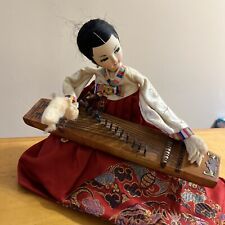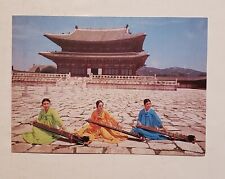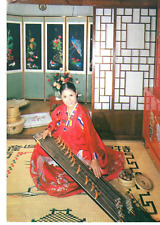When you click on links to various merchants on this site and make a purchase, this can result in this site earning a commission. Affiliate programs and affiliations include, but are not limited to, the eBay Partner Network.
Gayageum Korean zither with twelve strings tranditional musical instrument sound
The gayageum or kayagum is a traditional Korean zither-like string instrument,with 12 strings, though some more recent variants have 21 or other numbers of strings.It is probably the best known traditional Korean musical instrument.It is related to other Asian instruments, including the Chinese guzheng,the Japanese koto, the Mongolian yatga, and the Vietnamese đàn tranh.
History
According to the Samguksagi(삼국사기,三國史記) (1145), a history of the Three Kingdoms of Korea, the gayageum was developed around the 6th century in the Gaya confederacy by King Gasil (also known as Haji of Daegaya) after he observed an old Chinese instrument. He ordered a musician named Wu Ruk to compose music that could be played on the instrument. The original name was gayago and later gayageum. The gayageum was then further improved by Wu Ruk during the reign of Jinheung in the Shilla Dynasty.
The ancient gayageum of King Gashil was called by several names, including beopgeum (law-zither, 법금), pungnyu (elegance, 풍류), or jeong-ak (right music, 정악) gayageum. It is normally associated with accompaniment for court music, chamber music, and lyric songs. This type of gayageum has a wider spacing between the strings and plays slower tempo music such as Yeongsan-hoesang and Mit-doduri.
The sanjo gayageum is believed to have evolved in the 19th century with the emergence of sanjo music—which literally means scattered melodies, a musical form that involves fast tempos and some improvisation. The sanjo gayageum version of the instrument has closer string spacing and a shorter length to let musicians play the faster passages required for sanjo (Choi 2005). The sanjo gayageum is now the most wide spread form of gayageum.(KCMPC 2001). All traditional gayageum use silk strings, though, since the late 20th century, some musicians use nylon.
Modern versions of the gayageum with more strings often use nylon-wrapped steel strings, similar to those used for the Chinese guzheng (Choi 2005). Brass strings have also been introduced to produce a louder sound, which is preferred for accompanying dance (Park 2004). To play modern music, gayageum with a greater number of strings have been developed, increasing the instrument\'s range. Gayageum are available with 13, 17, 18, 21, 22, or 25 strings (Choi 2005), though instruments with more strings are available custom-made.photo of gayageum with 25 strings The 21 string gayageum is normally found in North Korea.
Construction
The beobgeum gayageum is 160cm long by 30cm wide by 10cm deep. Its body is made of a single piece of paulownia wood. The resonator chamber is hollowed out of the piece of paulownia.
The sanjo gayageum is about 142cm long by 23cm wide by 10cm deep. The soundboard is made of paulownia, but the sides and back are of a harder wood such as chestnut or walnut.(Choi 2005) (KCMPC 2001)
On the soundboard, anjok (movable bridges) support the strings. These bridges move to adjust the tuning and intonation. The strings enter the top of the body from tolgwae (tuning pegs) beneath. At the other end, the strings wind around free floating pegs, looped through holes at the bottom of the instrument, and then the strings are all tied in a coil (Choi 2005) (KCMPC 2001).
The left hand presses the strings to raise the pitch, and finger movements perform various movements such as shaking, bending, vibrating the strings. The right hand plucks or strums the strings. The Gayageum\'s tone is soft, delicate, and subtle. Legend says the Gayageum was first made by King Kasil in the Kaya Kingdom around the 6th century, and was further developed by Ureuk in the time of King of Jinhung in the Silla dynasty.
According to some evidence, however, it dates to a much earlier time than the Silla dynasty. Recent archaeological excavations in the Kwangsan areas in Jeolla-namdo Provincer revealed fragments of a Gayageum from around the 1st century BCE.
The Gayageum is employed in three different types of music, leading to variations of the instrument, including the:
Pungryu gayageum—the original form, with more widely spaced strings for slower-tempo worksSanjo gayageum—a smaller, modern version with more closely spaced strings to accommodate rapid playingNewer isibil hyongeum (21 string) instruments broaden the gayageum body and add more strings to increase the pitch range to accommodate contemporary music.
Safe and fast EMS shipping.EMS service will require a phone number for the recipient.Be sure to tell us your phone number.InformationShipment
We will ship your order within 3 business daysSafe and fast EMS Premium shipping.
It will usually take 5-7 business days after shipment.Payment
We accept only paypal payment.Return Policy
We carefully inspect the item before shipment.
In case you found a defect on the purchase, we will exchange or refund it.Contact Us
We are willing to respond to your inquiry.
If you have a question or problem, please contact us first.
It is the fastest way to settle your concern or issue. <div style=\"text-decoration:none\" target=\"_blank\"><img height=\"21px\" valign=\"middle\" align=\"center\"><font face=\"arial\"
<img target=\"_blank\"><img border=\"0\"></a> <div style=\"text-decoration:none\"







